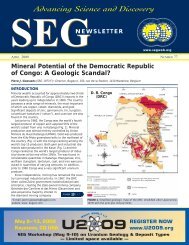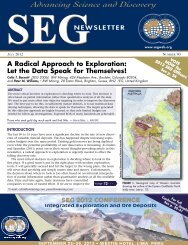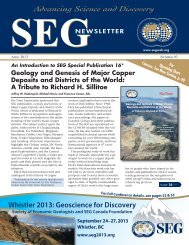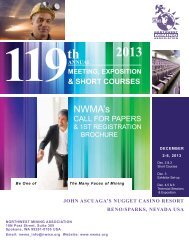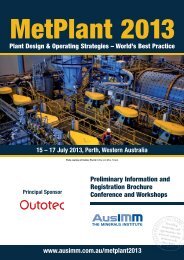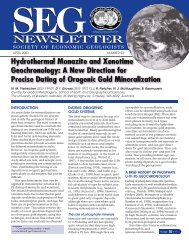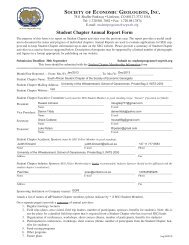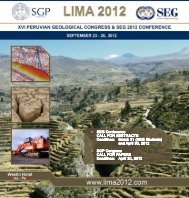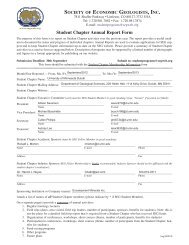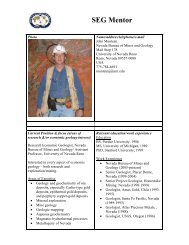Field Trip Report - Society of Economic Geologists
Field Trip Report - Society of Economic Geologists
Field Trip Report - Society of Economic Geologists
You also want an ePaper? Increase the reach of your titles
YUMPU automatically turns print PDFs into web optimized ePapers that Google loves.
Sweden field trip report: <br />
SEG Student Chapter ETH Zürich <br />
17 th -‐26 th <strong>of</strong> June 2013 <br />
Stockholm, Sweden was the starting point for the trip around central and northern <br />
Sweden joined by 8 members <strong>of</strong> the SEG Student Chapter Zürich. <br />
Stops on the first day included outcrops and dumps <strong>of</strong> the historic Bästnas and Norberg <br />
mining districts known for REE and Fe-‐mineralisation in skarns. <br />
On the second day NewBoliden hosted a visit to their Garpenberg “VMS” Zn-‐Pb-‐Ag <br />
deposit. Johann Olsson and Michaela Aberg took us on tour along a drift, which showed <br />
different kinds <strong>of</strong> mineralization including later Ag-‐veinlets crosscutting earlier Zn-‐ and <br />
Pb-‐mineralization in skarns. During the afternoon Åsa Erlfeldt and Giovanni Cibrario <br />
were hosting a small discussion round on the larger scale deposits geology. Afterwards <br />
they took us to the core-‐shed to show us the different metavolcanic and <br />
metasedimentary sequences and different mineralization types in core. <br />
On June 18 th we stopped at outcrops and dumps <strong>of</strong> the Garpenberg area to see the <br />
surface exposure <strong>of</strong> some skarn mineralization and volcanic sequences. In the late <br />
morning we reached the Stollbergsgruva, a historic mine for Ag and Fe. In the afternoon <br />
we made stops to visit the dumps <strong>of</strong> the Grängesberg Fe-‐oxide-‐Apatite deposit and old <br />
workings <strong>of</strong> the Kopparberg/Finngruvan Cu workings. <br />
After staying the night at Lake Alvlangen we visited BIF-‐horizons on the lakeshore and <br />
Accreted Lapilli in the surrounding area. Then we went on our way to the Persberg and <br />
Langban mineral districts, which are famous for their mineral diversity and historic <br />
mining for Fe-‐skarns. Persberg is furthermore known as the birthplace <strong>of</strong> the term <br />
skarn. <br />
On June 21 st , we went to the Unesco cultural world heritage site at Falun. This historic <br />
mine has been mined for Copper since the 10 th century. The rest <strong>of</strong> the day we used to <br />
reach our destination <strong>of</strong> the day, lake Orsa. <br />
On June 22 nd , we went on a long drive to the north. The destination was the Svartliden <br />
deposit. The employees <strong>of</strong> Dragon mining invited us to their midsummer festivities in <br />
the evening. On the following day Katerina Schloglova introduced us to the Svartliden <br />
Au-‐mine on the Gold-‐line. She gave us a detailed overview <strong>of</strong> the different lithologies the <br />
structural control <strong>of</strong> the deposit and gave us a tour around the open pit. After the visit <br />
we set <strong>of</strong> towards Galliväre with a stop at a pegmatite near Jokkmokk with huge feldspar <br />
and biotite crystals. <br />
On June 24 th , Gregory Joslin and S<strong>of</strong>ia Höglund took us around the NewBoliden Aitik Au-‐<br />
Cu. The day started with an introduction into the deposit characteristics and mining <br />
methods. In the pit they introduced us to the metavolcanic and metasedimentary host <br />
lithologies that were subject to Amphibolite facies metamorphism. Furthermore, they
took us to outcrops <strong>of</strong> later pegmatite veins. The disseminated chalcopyrite and <br />
chalcopyrite-‐stringer mineralization was also pointed out. Afterwards we were taken <br />
around the processing plant at Aitik with their autogenous mill and flotation plants. <br />
After our visit we drove to our most northern stop <strong>of</strong> the trip at Kiruna. On June 25 th <br />
Kari Niiranen gave us a tour around the largest underground Fe-‐mine in the world <br />
operated by LKAB. The day started with a presentation about the deposit its different <br />
stratigraphies and mining methods. The underground visit gave an insight into <br />
machinery used in large-‐scale underground mines and the following tour <strong>of</strong> on <strong>of</strong> the <br />
processing plants explained some <strong>of</strong> the difficulties and advantages <strong>of</strong> mining for <br />
Kiruna-‐type Magnetite-‐Apatite ore. The day was rounded <strong>of</strong> with a visit to the core shed <br />
where most significant stratigraphies could be investigated. <br />
On the long drive back to Stockholm from Kiruna we made one final stop at outcrops <strong>of</strong> <br />
the Alnö Carbonatite on the coast <strong>of</strong> the Baltic Sea, one <strong>of</strong> the prime examples for <br />
Carbonatites in Europe. <br />
We would like to thank everyone who has helped us with organizing this field trip. All <br />
mentioned geologists in the visited mines and the associated companies as well as <br />
several geologists familiar with the geology <strong>of</strong> Sweden who gave us precious tips on <br />
which deposits and outcrops to visit and access to older field guides and further <br />
literature (e.g. Erik Jonsson, Hannes Mattsson, Benni Mattsson and Torbjörn Bergmann). <br />
Furthermore, we are grateful for the substantial funding from Data Metallogenica and <br />
the SEG!
Sulfide mineralization in skarn with later veinlets rich in Ag at the Garpenberg mine
Metre-‐scale biotite and feldspar crystals at a pegmatite near Jokkmokk
The Aitik Au-‐Cu open-‐pit mine
Participants <strong>of</strong> the field trip on the arctic circle



